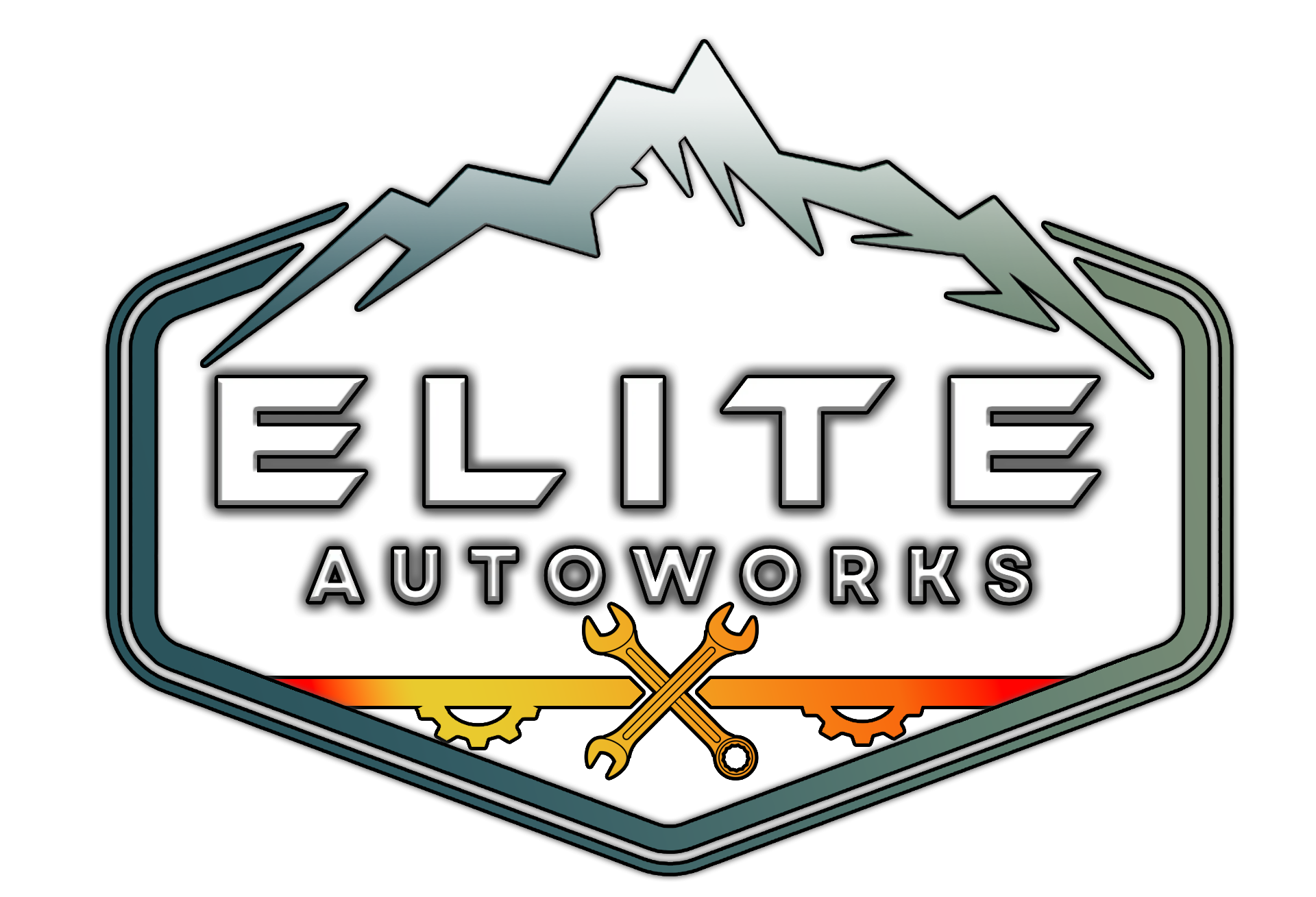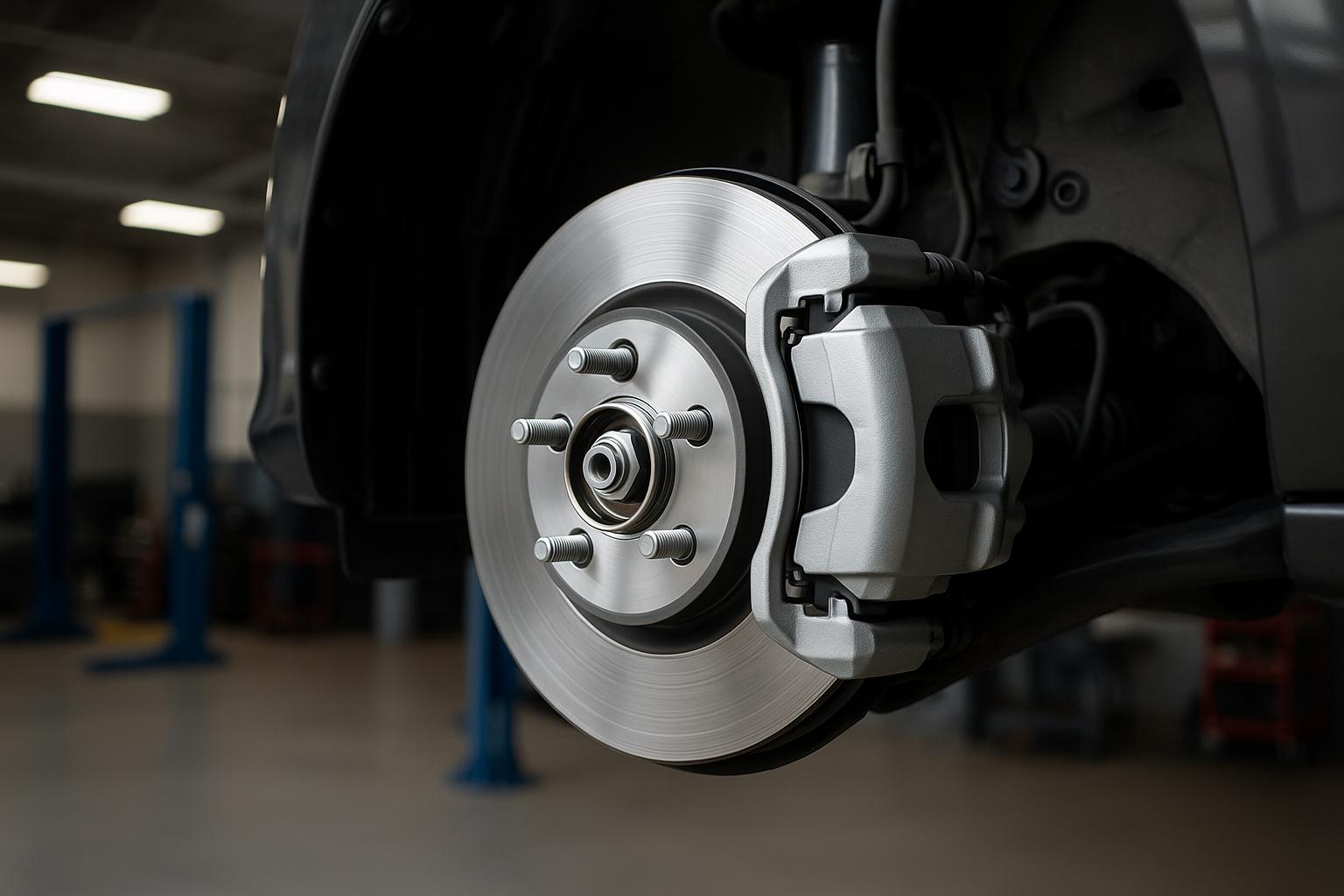Don’t Ignore These Critical Brake Symptoms
Your vehicle’s braking system is, without a doubt, its most critical safety feature. Living in Castle Rock, Colorado, with its varying terrain and weather conditions, puts extra emphasis on ensuring your brakes are always in optimal condition. Ignoring early warning signs can lead to more extensive damage, costlier repairs, and, most importantly, compromise your safety on the road. Being attentive to changes in your car’s braking performance can save you from potential hazards and significant expenses.
At Elite Auto Works, we believe in proactive vehicle care. Understanding these common brake wear symptoms will help you know when it’s time to seek professional help from our ASE Master-Certified technicians.
The 5 Crucial Warning Signs
1. Unusual Noises: Squealing, Grinding, or Clicking
One of the most common and earliest indicators of brake trouble is unusual sounds when you apply the brakes. High-pitched squealing or screeching often means your brake pads are wearing thin. Many brake pads are designed with a small metal wear indicator that makes this noise when the pad material is low. If you hear a grinding or growling sound, it’s a more serious issue. This typically signifies that the brake pads have worn down completely, and the metal backing plate is now grinding against the rotor. This metal-on-metal contact can quickly damage rotors and lead to more expensive repairs. Clicking noises can sometimes point to loose components within the brake assembly.
2. Reduced Responsiveness or Spongy Pedal
If your brake pedal feels soft, spongy, or sinks further to the floor than usual when you press it, this is a significant warning sign. A “spongy” or “mushy” pedal often indicates air or moisture in the brake lines, or a problem with the master cylinder. This compromises the hydraulic pressure needed for effective braking, leading to increased stopping distances. You might find yourself having to pump the pedal to achieve adequate braking power. Any change in the feel or responsiveness of your brake pedal warrants an immediate brake inspection.
3. Vehicle Pulling to One Side When Braking
When you apply the brakes, your vehicle should stop in a straight line. If it consistently pulls to one side (left or right), this indicates an issue within the braking system. Common causes include a stuck brake caliper, a collapsed brake hose restricting fluid flow to one side, or unevenly worn brake pads. A stuck caliper means one brake might be applied more forcefully or not at all, causing the imbalance. This can be particularly dangerous, especially during sudden stops or on slick Castle Rock roads.
4. Vibrations or Pulsating Brake Pedal
Feeling a vibration, pulsation, or shaking through the brake pedal or steering wheel when braking is often a sign of warped brake rotors. Brake rotors can warp due to excessive heat buildup, often from prolonged or hard braking, such as driving in mountainous terrain or frequent stop-and-go traffic. When rotors are warped, the brake pads make uneven contact, causing the pulsating sensation. While sometimes confused with ABS activation (which can also cause pulsation in emergency stops), persistent vibration during normal braking means your rotors likely need attention.
5. Brake Warning Light On
Your dashboard brake warning light is a direct communication from your vehicle’s onboard diagnostic system that something is amiss. This light can indicate several issues, from a simple problem like the parking brake being engaged to more serious concerns like low brake fluid, a problem with the ABS (Anti-lock Braking System), or significantly worn brake pads. If this light illuminates, (and it’s not just your parking brake), it’s crucial to have your brake system checked immediately. Sometimes, this may also be linked to issues that trigger the check engine light, indicating a broader system concern.
Why Regular Brake Checks are Essential
Regular brake inspections are fundamental to your safety and your vehicle’s longevity. Proactive checks can identify minor issues before they escalate into major, costly repairs. Well-maintained brakes not only provide peace of mind but also enhance your vehicle’s overall performance and can even contribute to maintaining its resale value. In Castle Rock, where driving conditions can change rapidly, from sunny days to snowy roads, knowing your brakes are reliable is paramount.
Quick ‘Did You Know?’ Brake Facts
- Disc vs. Drum Brakes: Most modern vehicles use disc brakes on the front wheels, and many now have them on all four. Disc brakes generally offer better stopping power, especially in wet conditions. Some vehicles, particularly older models or smaller cars, may still use drum brakes on the rear wheels.
- Brake Fluid is Hygroscopic: This means brake fluid absorbs moisture from the air over time. Contaminated fluid can lower the boiling point, leading to reduced braking efficiency (“brake fade”) and can also cause corrosion in the brake lines and components. That’s why regular brake fluid checks and flushes are important.
- Brake Pad Lifespan Varies: The lifespan of brake pads can range significantly, typically from 25,000 to 70,000 miles (or about 40,000 to 110,000 kilometers). This depends heavily on driving habits (city vs. highway), the type of brake pad material, vehicle weight, and even the terrain, like the hilly areas around Castle Rock.
- Rotors Don’t Last Forever: While typically lasting longer than brake pads (often through two or three sets of pads), brake rotors also wear down and can warp. They may need resurfacing or replacement.
What to Do if You Notice These Signs
Step 1: Don’t Panic, But Don’t Ignore
If you notice any of these warning signs, remain calm but take them seriously. Your brakes are signaling a problem that needs attention.
Step 2: Adjust Your Driving
Immediately reduce your speed and increase your following distance from other vehicles. Avoid hard braking if possible. If the symptoms are severe, consider pulling over safely and arranging for your vehicle to be towed.
Step 3: Schedule a Professional Brake Inspection
Contact a trusted auto repair shop, like Elite Auto Works, to schedule a comprehensive brake inspection as soon as possible. Driving with compromised brakes puts yourself and others at risk.
What Happens During a Professional Brake Inspection at Elite Auto Works?
When you bring your vehicle to Elite Auto Works for a brake inspection, our ASE Master-Certified technicians perform a thorough evaluation of your entire braking system. This typically includes:
- Visual inspection of brake pads and shoes for wear.
- Measuring brake pad thickness and comparing to manufacturer specifications.
- Inspecting brake rotors (discs) and drums for wear, warping, heat spots, or cracks.
- Checking brake fluid level and condition (looking for contamination).
- Inspecting brake lines and hoses for leaks, cracks, or corrosion.
- Examining calipers and wheel cylinders for proper operation and leaks.
- Checking the parking brake functionality.
- If necessary, using advanced diagnostic tools like those found for engine diagnostics to assess any related electronic system faults (e.g., ABS).
We prioritize transparency, so we’ll explain our findings clearly and provide honest recommendations for any necessary repairs, ensuring you understand the work needed and why.
Your Trusted Castle Rock Brake Service Experts
Driving in Castle Rock and the surrounding Colorado areas means your vehicle’s brakes work hard. From navigating hilly terrain to dealing with sudden stops in traffic or adverse weather like snow and ice, your brakes are constantly being tested. This is why having a local, trustworthy auto repair shop is essential. Elite Auto Works is proud to be a family-owned business serving the Castle Rock community. We specialize in Japanese imports like Toyota, Lexus, Honda, and Subaru, but our factory-trained technicians expertly service all makes and models. Our commitment is to provide dealership-level expertise with the honesty and value you expect from a local shop. Whether it’s routine oil changes and fluid services that include a brake check, or a dedicated brake repair, we’re here for you.
Worried About Your Brakes?
Don’t wait for a small issue to become a major safety hazard. For expert brake inspection and repair in Castle Rock, trust the experienced team at Elite Auto Works.
Frequently Asked Questions (FAQ)
How often should I get my brakes checked?
It’s generally recommended to have your brakes inspected at least once a year or every 12,000 miles, whichever comes first. Many shops, including Elite Auto Works, will check them during routine maintenance like tire rotations or oil changes. However, if you frequently drive in heavy traffic, hilly terrain (common around Castle Rock), or notice any warning signs, you should have them checked sooner.
What’s the difference between brake pads and brake rotors?
Brake pads are the friction material that presses against the brake rotors (or discs) to slow down and stop your vehicle. Rotors are the metal discs that the wheels are attached to. The pads wear down with use and need regular replacement. Rotors also wear down but typically last longer than pads.
How long do brake repairs usually take at Elite Auto Works?
The time required for brake repair depends on the extent of the work needed. A simple brake pad replacement might take a couple of hours, while more complex jobs like rotor replacement or caliper issues could take longer. We always aim to complete work efficiently while ensuring quality. We can provide a more accurate time estimate after inspecting your vehicle. For significant work like a timing belt replacement, we ensure to communicate timelines clearly.
Can I drive my car if the brake warning light is on?
It’s highly discouraged. A brake warning light indicates a potential problem with your braking system. Continuing to drive could worsen the issue, lead to more expensive repairs, or result in brake failure. It’s best to have your vehicle inspected by a professional immediately. If you’re unsure about driving it, it’s safer to have it towed.
Are your technicians certified for brake repairs?
Yes, our technicians at Elite Auto Works are ASE Master-Certified and factory-trained. We have extensive experience with brake systems on all makes and models, including specialized knowledge of Japanese imports. You can learn more about us and our commitment to quality service on our website.
Glossary of Brake Terms
- Brake Caliper: A component in disc brake systems that houses the brake pads and pistons. When you apply the brakes, the caliper squeezes the brake pads against the rotor.
- Brake Rotor (Disc): A metal disc connected to the wheel hub that rotates with the wheel. Brake pads clamp onto the rotor to create friction and slow the vehicle.
- Brake Pads: Friction material that is pressed against the brake rotor (in disc brakes) or the inside of the drum (in drum brakes) to create the friction needed to stop the vehicle.
- Brake Fluid: Hydraulic fluid used in braking systems to transfer force from the brake pedal to the brakes at the wheels.
- ABS (Anti-lock Braking System): A safety system that prevents wheels from locking up during hard braking, allowing the driver to maintain steering control.
- Master Cylinder: A component that converts the pressure from the brake pedal into hydraulic pressure, which is then transmitted to the brakes via brake fluid.

